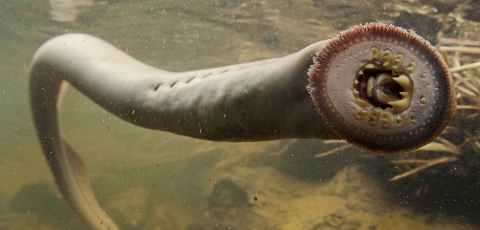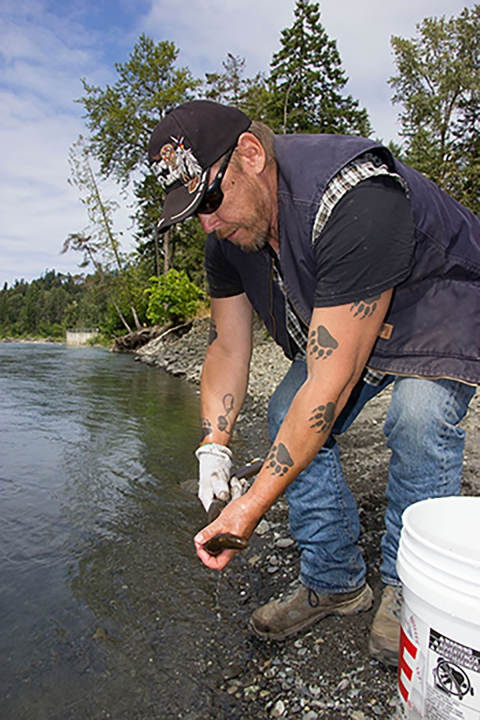Lamprey have been around for more than 400 million years. They have survived several mass extinction events and outlasted dinosaurs. Beloved by many and misunderstood by some, there is a certain mystique about these denizens of the deep that are found across the globe.
But their future in the Pacific Northwest and across the globe remains murky as they face the challenge of climate change climate change
Climate change includes both global warming driven by human-induced emissions of greenhouse gases and the resulting large-scale shifts in weather patterns. Though there have been previous periods of climatic change, since the mid-20th century humans have had an unprecedented impact on Earth's climate system and caused change on a global scale.
Learn more about climate change .
“Water connects us all,” says Christina Wang, deputy project leader for the U.S. Fish and Wildlife Service’s Columbia River Fish and Wildlife Conservation Office in Vancouver, Washington and co-author on a new study examining climate change and worldwide lamprey populations. “Climate change has real and negative impacts on our rivers, our oceans, and all the species that rely on them — including humans. Losing lampreys could be a harbinger of things to come for us.”
Lampreys: Ancient Teachers
Lampreys can help us understand the future of our changing world, in part, because they have a long history and a wide distribution. With approximately 40 species of lampreys recognized worldwide, they can be found on all continents except Africa. Lampreys belong to a primitive group of fishes that are eel-like in form but that lack the jaws and paired fins of bony fishes.
Masters of adaptation, modern lampreys have been called “living fossils” due to their relatively unchanged anatomy and unique parasitic feeding style. Lampreys are characterized as either resident or anadromous. Resident lamprey they spend their whole life cycle in fresh water, but anadromous lamprey are hatched in fresh water, migrate to the ocean to feed and return to fresh water to reproduce.
Regardless of your level of lamprey love, we all have a reason to learn more about these fascinating fishes — it may tell us what the future holds for our environment.
A recent study co-authored by researchers from the U.S. Fish and Wildlife Service and scientists from the National Research Institute for Agriculture, Food and Environment (INRAE) in France and Ishikawa Prefectural University in Japan, climate change is impacting global lamprey populations and, as a result, impacting human communities. Published in the Journal of Great Lakes Research in the summer of 2021, the study examines the connections between current and future changing environmental conditions and lamprey anatomy, life cycle and distribution, and functional roles in the marine and continental ecosystems, including the services they provide to communities.
After all, who better to teach us about the future of our environment than an ancient, adaptable fish that has weathered hundreds of millions of years of change?
Why Study Lampreys and Climate Change?
Notable for both its international scope and innovative focus area, this study analyzed lamprey data and climate change data from around the world.
“Climate change is a global problem and lampreys are global fishes; it made sense to look at the relationship between the two,” says Wang. “This is the first time we have joined forces internationally on lampreys and climate change, so it was exciting to collaborate across the continents.”
Geraldine Lassalle, a scientist at INRAE in France, echoes Wang’s enthusiasm for sharing lamprey science.
“We each brought a crucial piece of the puzzle to the table — the Northwestern U.S. had data on Pacific lamprey, our Japanese colleague spent years studying Arctic lamprey in his country, and here in Europe we are very concerned about the endemic river lamprey as well as the sea lamprey.”
Western brook lamprey, found from southeast Alaska to California, and European brook lamprey, inhabiting rivers and lakes in Northwest Europe, Portugal and Italy, are examples of freshwater-resident lampreys. Their anadromous counterparts tend to be more widely distributed due to their migratory behavior and their ability to latch on to their host species. For instance, the Arctic lamprey has a range that extends from the east around Lapland southward around Japan; the Pacific lamprey can be found in streams around the Pacific Rim including Alaska, Canada, Washington, Oregon, Idaho, and California to Punta Canoas, Baja California, Mexico. The European sea lamprey is endemic to both sides of the Atlantic Ocean, but was introduced to the Great Lakes where it is now considered an invasive species.
Lampreys and Humans: Connected Communities
Where lampreys make their homes matters for human neighborhoods. Here in the Pacific Northwest, there are three species of lamprey — western, brook, and Pacific — that play important cultural, economic, and ecological roles.
“The health of lampreys is linked with the health of aquatic ecosystems and vice versa,” says Wang.
At every life stage, they are a food source for many species and act as filters for water and sediment during the larval stage to keep our rivers clean. Once anadromous lamprey die, their bodies return nutrients to aquatic ecosystems, providing a crucial connection between the ocean and the river. The fitness of humans depends on the fitness of our waterways and the more lamprey abound, the better shape we are in.
“Lampreys are an indicator of aquatic ecosystem health,” says Wang. “They can really tell us a lot about how our aquatic ecosystem is doing and, more broadly, how our environment at large, is doing.”
Along with their role as essential elements of our environment, lampreys are also culturally significant. Native American Tribes in the Pacific Northwest, for instance, have long considered the Pacific lamprey an ancient neighbor that has sustained tradition since time immemorial. Many Tribes in the Columbia River Basin, coastal Oregon, Washington and California harvest Pacific lamprey each year and rely on lampreys as source of food and for ceremonies.
Communities in France and Portugal also depend on lampreys for dietary purposes in traditional dishes like stews (e.g. lamprey à la Bordelaise in France or Arroz de lampreia in Portugal). Lampreys are even being studied for their medicinal value in the fight against cancer.
It is clear that we humans are linked to lampreys. Despite the lamprey’s often parasitic nature, their relationship to us is one of mutual benefit. We need them and they need us. The work of Wang, Lassalle and their colleagues highlights both how lampreys can help us learn about climate change and how we can help them survive for another few millennia.
Climate Change and Lampreys: Today’s Trends and Tomorrow’s Forecast
The study outlines the widely ranging conservation status of lampreys worldwide — from threatened to a species of least concern — and shows that climate change is among the challenges facing lampreys. In order to figure out how climate change is impacting lampreys now and make projections for the future, the authors of this study had to first describe how the climate is changing. The most straightforward way to do this, according to Wang, was to look at variables like precipitation and water temperature over a period of time in specific locations. This study looked at data from Western Europe, the Northwest United States, and Japan over the past several decades.
The data showed significant changes in precipitation for both the fresh and saltwater homes of lampreys around the world. In all three regions in the study, there was a notable warming trend while precipitation was more varied depending on the time of year and location. Increased temperature is causing considerably less snowpack, evident in places like the Cascade Mountain range in the Pacific Northwest, where it has decreased 20% since the 1950s.
“Once we saw that the climate is indeed changing, our next step was to look at how it might be influencing lampreys now and project these trends into the future,” says Wang.
Warmer temperatures, shifting rainfall patterns, and reduced snowpack as a result of increasing greenhouse gases all seem to have a compounding effect on lampreys.
“There is a strong correlation between our changing environment and lamprey distribution, anatomy, and seasonal lifecycle” says Lassalle. “Lampreys are doing their best to adapt to the rapidly changing conditions by moving away from warm waters, hatching and migrating sooner, and, sadly, producing lower quality gametes (eggs and sperm), which hinders reproduction.”
Lampreys have been around longer than trees, surviving at least four mass extinction events. It would be logical to assume these adaptable fishes will continue to go with the flow, changing with the world around them. While it is true that lampreys are some of the most resilient aquatic species on the planet, and actually quite temperature tolerant, this kind of climate change (versus those caused by sudden events millions of years ago), may be harder for the lampreys to adapt to.
“While I would like to say that the lampreys can handle anything, our data shows otherwise,” says Wang. “Where millions of years ago, the lampreys had some kind of a refuge during mass extinction events, now they have fewer options because humans have fundamentally altered the river systems. Climate change is magnifying the effect of other threats that lampreys, and the food webs they depend on, are facing.”
The interconnectivity that Wang describes looks to be at risk for further fragmenting in the future. Using the existing data on climate change and lampreys, the study made projections for the future of climate change and lampreys. Although previous studies showed that lampreys are vulnerable to climate change, this research gives us a clearer picture of what might happen to them if the current pace of change continues.
“We could certainly be facing a future with fewer lampreys,” says Lassalle. A lack of lampreys doesn’t bode well for humans.
Despite the poor projections, Wang, Lassalle, and their co-authors are hopeful that humans can be agents of change in a positive direction for lampreys. According to the study, a key factor in determining the future susceptibility of lampreys to climate change is “the degree to which their habitats are altered.” We humans can remove or correct negative alterations to lamprey habitats such as degraded floodplains and passage barriers, and restore them to more lamprey-friendly environments (like this one).
Just as negative changes will compound over time, so too will positive changes. The Biden Administration’s America the Beautiful initiative is an example of one change that will have positive impacts on future generations of lamprey and people. By aiming to conserve 30 percent of our Nation’s lands and waters by 2030, this innovative plan will help protect lampreys and other anadromous fish from climate change.
The next step for this research, according to both Wang and Lassalle, is deciding how and where to prioritize future projects for lamprey conservation.
“Through the partnership of this study, we now have this foundational and international research showing the current and future impacts of climate change on lampreys,” says Wang. “Our next step is using the data to plan for reconnecting and restoring vital aquatic habitat — a positive change that will help us all.”
Resources
- Christina J. Wang, J. Michael Hudson, Géraldine Lassalle, Timothy A. Whitesel, Impacts of a changing climate on native lamprey species: From physiology to ecosystem services, Journal of Great Lakes Research, Volume 47, Supplement 1, 2021, Pages S186-S200, ISSN 0380–1330, https://doi.org/10.1016/j.jglr.2021.06.013.
- https://www.sciencedirect.com/science/article/pii/S0380133021001520
- Vulnerability Assessment: https://www.tandfonline.com/doi/full/10.1080/02705060.2019.1706652
- Pacific Lamprey Conservation Initiative: https://www.fws.gov/PacificLamprey/mainpage.cfm
- Why lamprey matter to Columbia Basin Tribes, a video by Columbia River Inter-Tribal Fish Commission: https://youtu.be/RIsRfSoCvXA
- The Lost Fish video: https://vimeo.com/wemayfly/thelostfishfilm
- The Pacific Lamprey Experience— a coloring and activity book
You can find this article here on our USFWS Pacific Medium blog along with additional maps and climate change data related to Pacific lamprey






